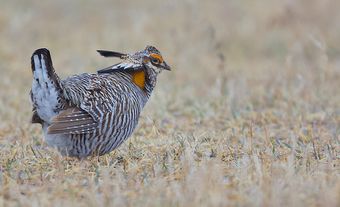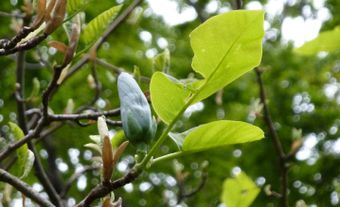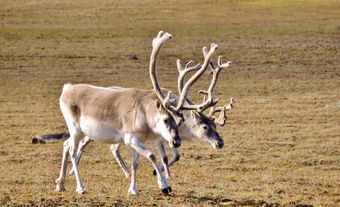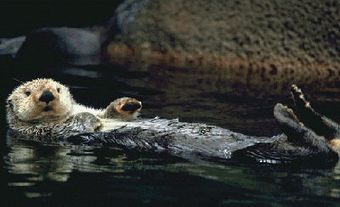Many animals in Canada face the risk of extinction. Animals are put at risk for several reasons, including: climate change, the loss of forest and grassland to cities and agriculture, hunting, fishing, and the pollution of lakes and rivers. As of 2021, 554 animal species are at risk in Canada, according to the Committee on the Status of Endangered Wildlife in Canada. In addition, 18 are extirpated and 18 extinct. The committee’s definition of a wildlife species includes taxonomic categories as well as geographically distinct populations. For example, the beluga whale (Delphinapterus leucas) is included in the list of at risk animal species six times, as there are six different populations facing different threats to their survival. (See also Endangered Plants in Canada.)

Key Terms
|
Native Species |
A species that historically lives in a particular habitat. |
|
Extinct |
The species no longer exists anywhere in the world. |
|
Extirpated |
The species no longer exists in the wild in Canada, but lives elsewhere. |
|
Endangered |
The species is at risk of becoming extirpated or extinct. |
|
Threatened |
The species is at risk of becoming endangered. |
|
Special Concern |
The species is at risk of becoming threatened or endangered. |
Designations and Legislation
In 2002, the Government of Canada passed the Species at Risk Act, its first endangered species act. Under that legislation, the Committee on the Status of Endangered Wildlife in Canada (COSEWIC) decides which species are at risk. COSEWIC is funded by Environment Canada, but it otherwise operates independently of the government. COSEWIC commissions studies of native species whose survival in Canada might be at risk. Based on that research it places them in one of five categories: extinct, extirpated, endangered, threatened, or special concern.
Canadian Case Studies
Sea Otter

During the late 1700s and 1800s, the sea otter was heavily hunted on the Pacific coast. Hunters sold as many as 1,200 pelts per year. By 1900, sea otters were on the verge of extinction; the last documented sighting in British Columbia was in 1929. An international treaty (1911) gave protection to the endangered sea otters, and by the late 1960s the Alaskan population had grown to about 30,000. Between 1969 and 1972, some sea otters from Alaska were moved to the west coast of Vancouver Island. The move was successful, and the BC population is now several thousand animals. The status of sea otters was reduced from endangered to threatened in 1996, and to special concern in 2007.
Peregrine Falcon
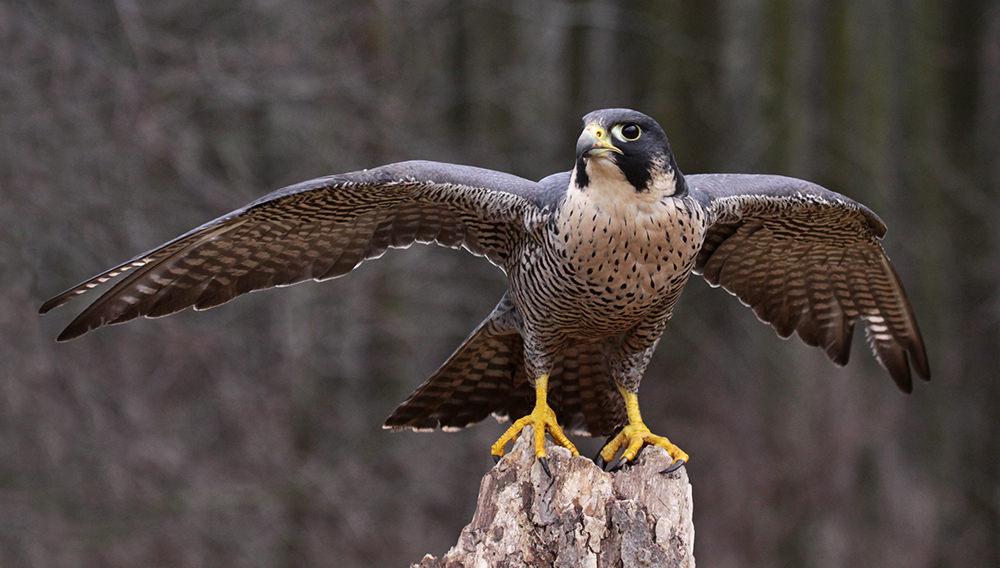
Many populations of peregrine falcons in Canada were wiped out by organochlorine chemicals such as DDT and PCBs. These chemicals cause various problems, such as reducing calcium in eggshells so that they break under the weight of the parent sitting on them. However, since the manufacturing and use of organochlorines was banned in the 1970s, populations of peregrine falcons are now increasing. In 2017, the status of two peregrine falcon subspecies in Canada, Falco peregrinus anatum and Falco peregrinus tundrius, changed from special concern to not-at-risk.
Greater Prairie-Chicken
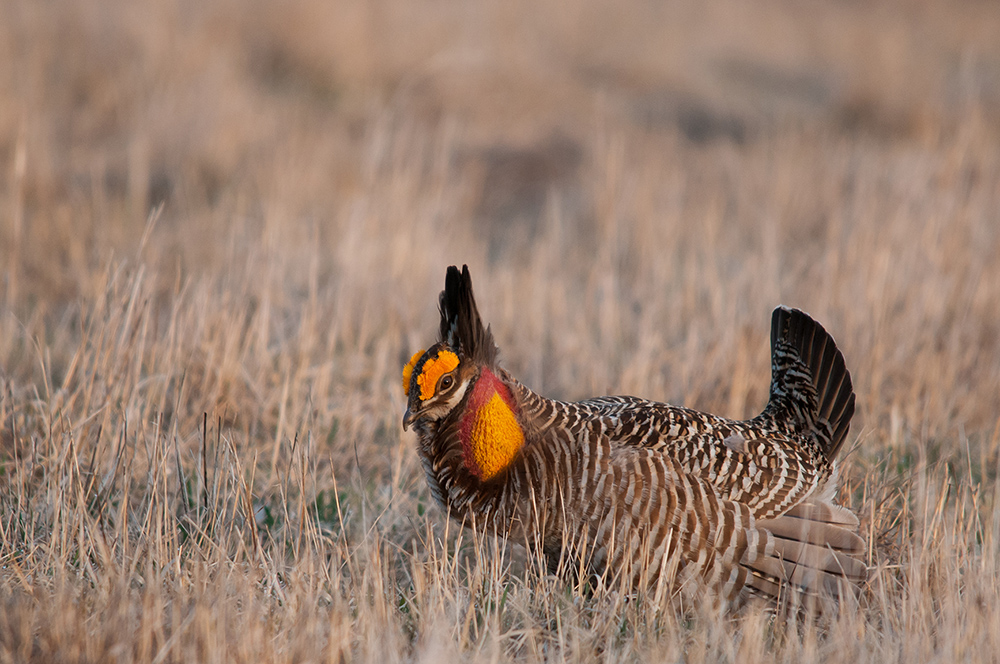
Large populations of greater prairie chickens once lived in the prairies of Alberta, Saskatchewan, Manitoba and Ontario, but they are now extirpated. Greater prairie chickens lived on native grasslands, and continued to flourish when small-scale farms developed in the early 1900s. However, when vast amounts of prairie grassland were converted to cultivated crops, the habitat was no longer suitable and the species disappeared from its Canadian range. Although the greater prairie chicken is extirpated in Canada it still survives in the U.S., where it is endangered. Grasslands National Park, Saskatchewan, is large enough to perhaps attempt a re-establishment of this species in Canada.
Leatherback Turtle
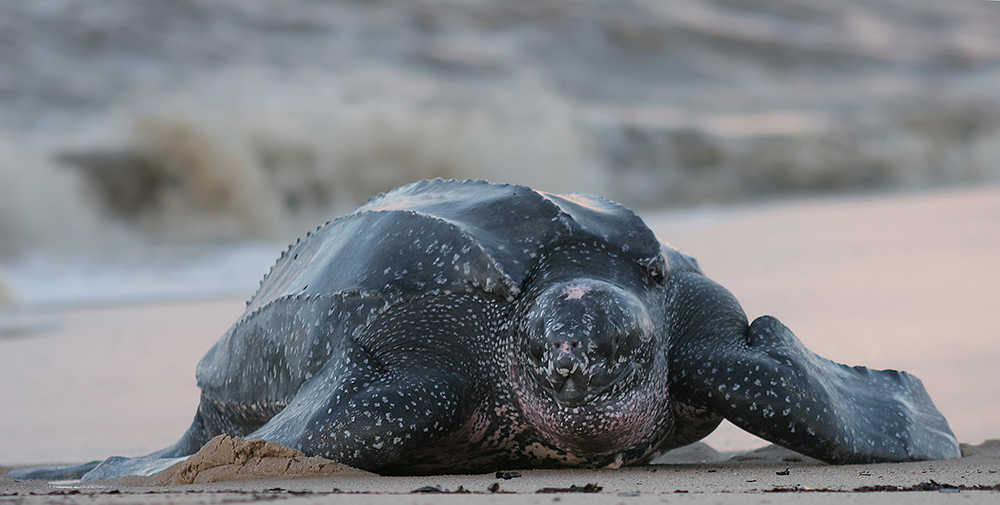
The leatherback sea turtle is a large marine reptile that breeds on sandy tropical beaches. It migrates to Canadian waters in the summer to feed on jellyfish. There are regular but limited sightings of this species in the Atlantic Ocean as far north as southern Greenland, and on the West Coast to southern Alaska. Although adult turtles are occasionally tangled in fishing gear in Canadian waters, most are killed in tropical waters. In tropical parts of the world, humans collect and eat turtle eggs, and sometimes kill and eat adult turtles. The leatherback sea turtle is considered endangered in Canada. The conservation of this species requires international co-operation.
Atlantic Whitefish
The Atlantic whitefish was only “discovered” as a distinct species in 1967. Its global range is limited to the watersheds of the Tusket River and Petite Rivière in southern Nova Scotia. Both populations are endangered. In the Tusket River, a dam built in 1929 blocked the Atlantic whitefish's spawning migration to and from the sea. In the Petite Rivière, introduced fish, such as the smallmouth bass, have affected the Atlantic whitefish population. More recently, acid rain may be affecting the habitat of the Atlantic whitefish.
Caribou

There are several populations of caribou in Canada, all belonging to the same species (Rangifer tarandus). They live primarily in the northern reaches of the country, in every province and territory except Prince Edward Island, Nova Scotia and New Brunswick. Researchers give each population a separate classification. In 2019, the Committee on the Status of Endangered Wildlife in Canada listed six populations as endangered, three as threatened and two as special concern. Additionally, one subspecies (Rangifer tarandus dawsoni) became extinct in the 1920s. There are many reasons why caribou are at risk in Canada, and among them is climate change. Warmer temperatures mean that many of caribou’s predators, including wolves, cougars and coyotes, are able to live further north. Climate change is also changing the timing of when Arctic ice melts and freezes. Since caribou use ice to travel, these changes affect their migration patterns and access to food.
Habitat Protection
While it is obvious that protection from hunting and fishing is needed to save a species from extinction, it is also true that natural habitats must also be protected. Various organizations work to conserve animal habitats, including federal, provincial, territorial, municipal and Indigenous governments. Any of those governments can turn land that they own into a protected area. The most highly protected areas are ecological reserves and wilderness areas, in which only a low intensity of use is permitted, such as hiking and nature study. Parks are also a kind of protected area, although often a great deal of activity is permitted, such as tourism.
The private sector also has a key role to play in protecting natural habitats. For example, many large forestry companies have set aside parts of their land base to conserve natural habitats. In addition, many individual landowners manage their land to conserve habitats needed by native species. Finally, certain non-governmental organizations, such as the Nature Conservancy of Canada and Ducks Unlimited Canada, are buying private properties and setting them aside as protected. These protected properties support native species, including endangered species.
Research and Management of Endangered Species
Several organizations are engaged in the study and management of rare and endangered species. All levels of government in Canada have some degree of mandate to do this, usually through specialists in their departments of environment or natural resources. The Canadian Museum of Nature in Ottawa and provincial and university museums also do this, although their resources are quite limited. The Canadian Wildlife Service has a role in managing and studying Canada's migratory birds, and Fisheries and Oceans Canada in managing and studying fishes and sea mammals. Certain non-governmental organizations, such as the Canadian Wildlife Federation, Canadian Nature Federation, Ducks Unlimited Canada, Nature Conservancy of Canada and World Wildlife Fund (Canada) also engage in research about endangered wildlife.
International Agreements
Canada is a signatory to the Convention on International Trade in Endangered Species (CITES), which regulates trade in rare and endangered species or their by-products. Canada has also ratified the International Convention on Biological Diversity and thereby assumes certain obligations for conserving biological diversity and the sustainability of its components (see Biodiversity). Because these international treaties involve Canada as a whole, all other governments in Canada are also held to their provisions and responsibilities, as are Canadian citizens.

 Share on Facebook
Share on Facebook Share on X
Share on X Share by Email
Share by Email Share on Google Classroom
Share on Google Classroom

